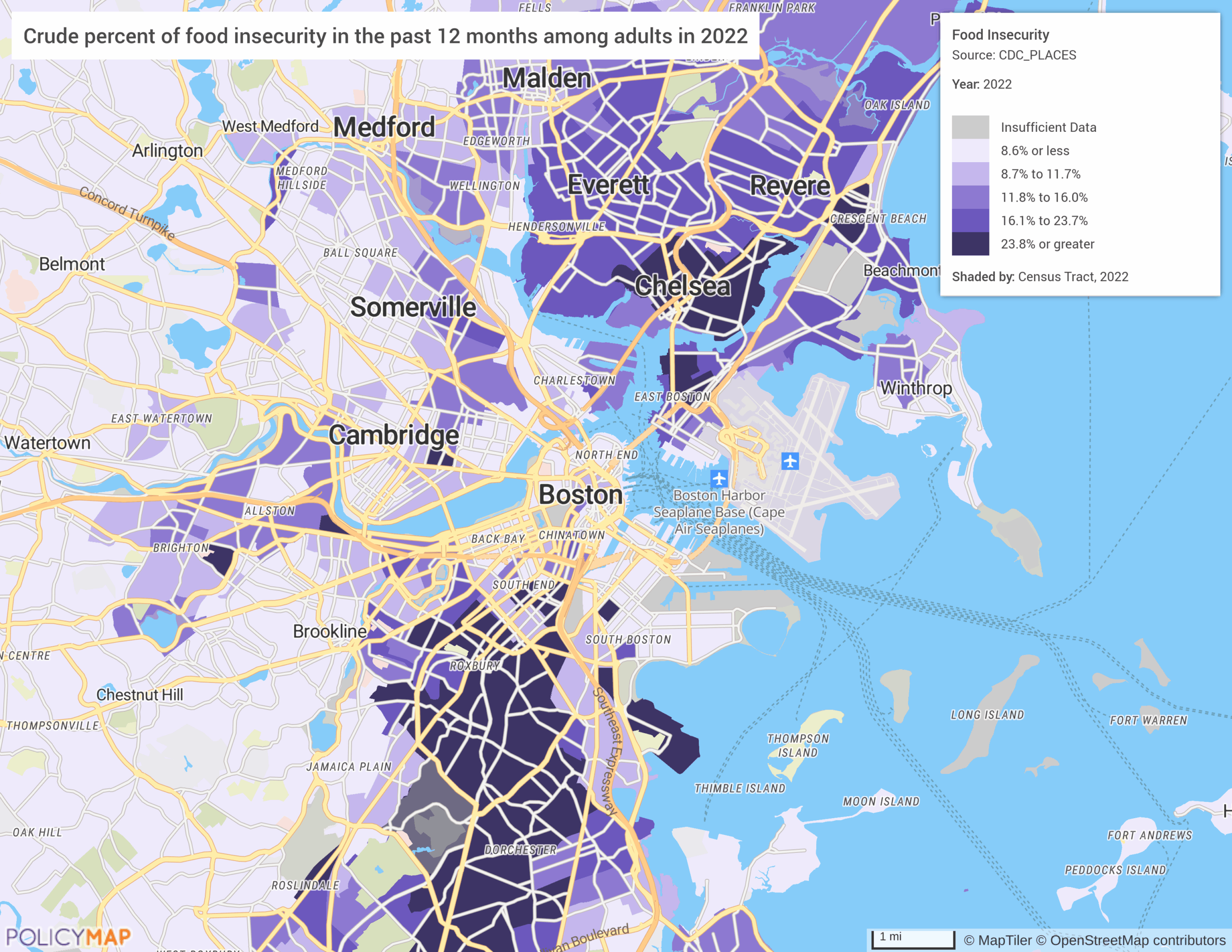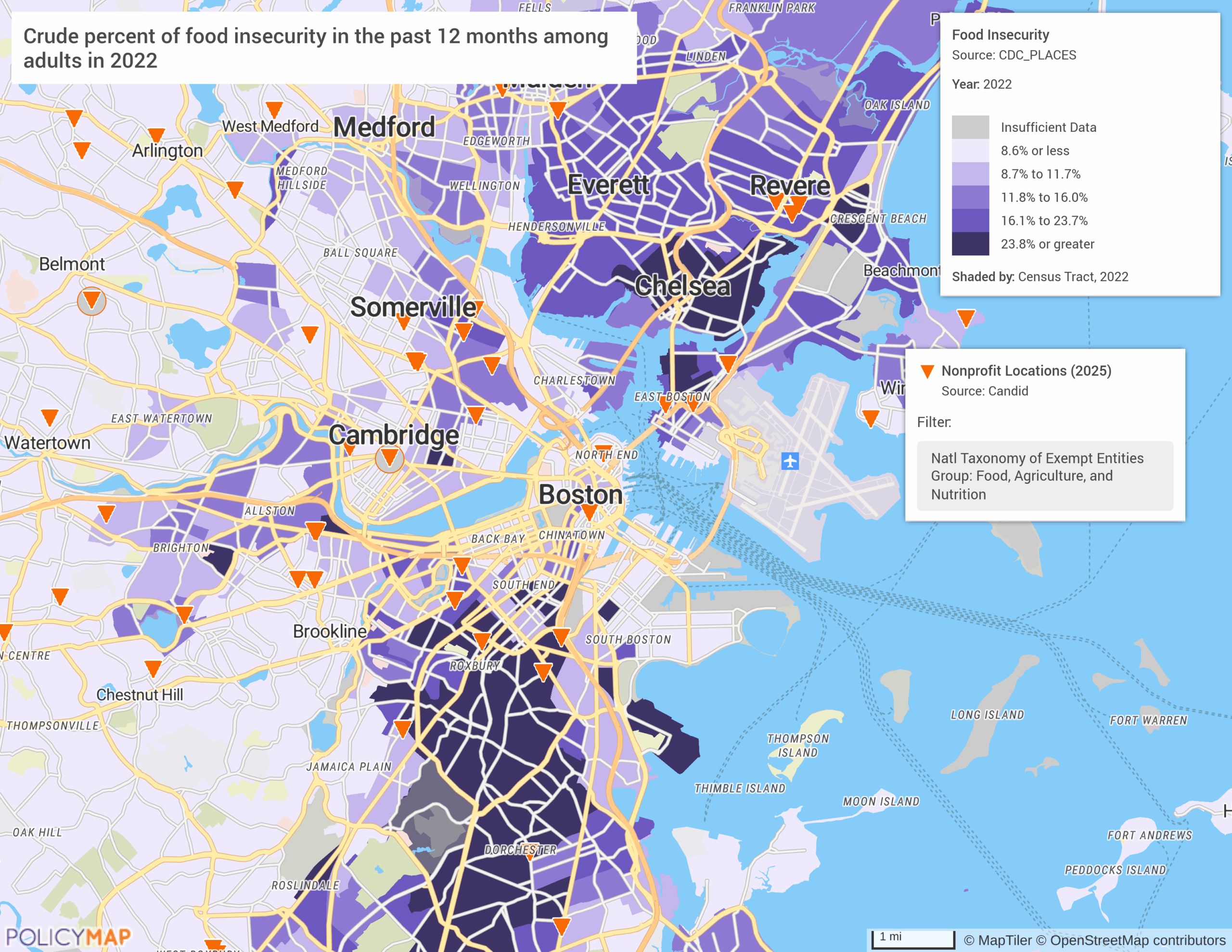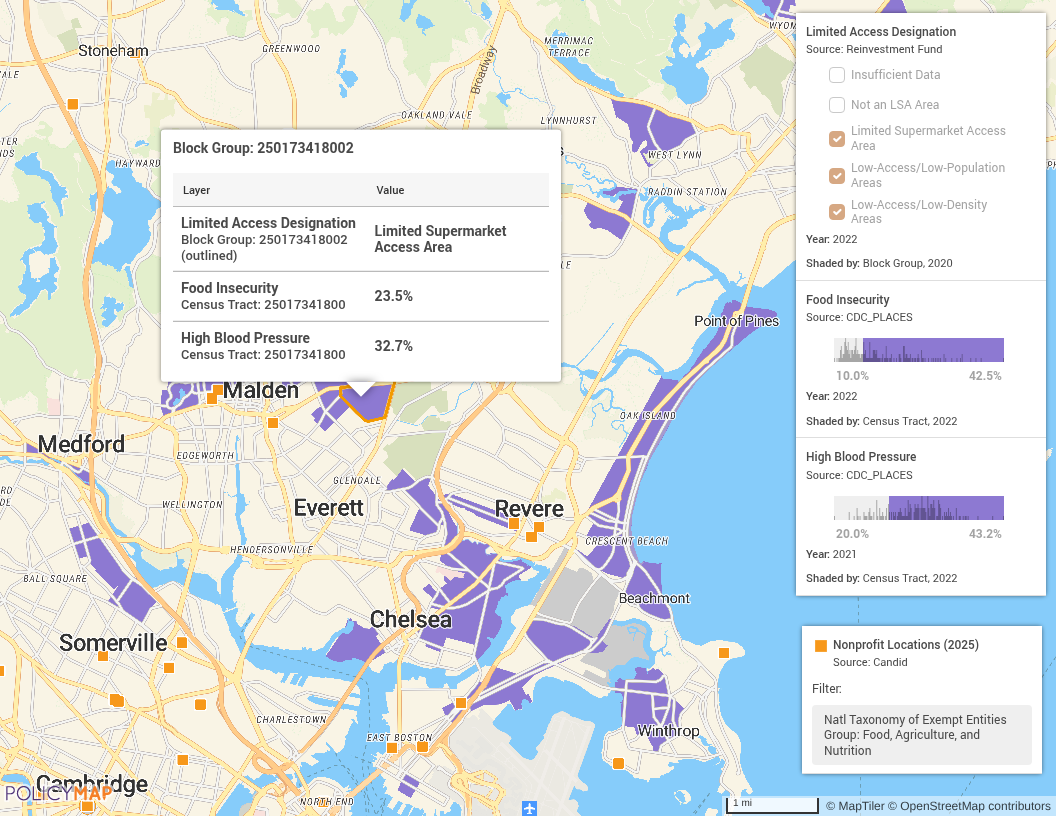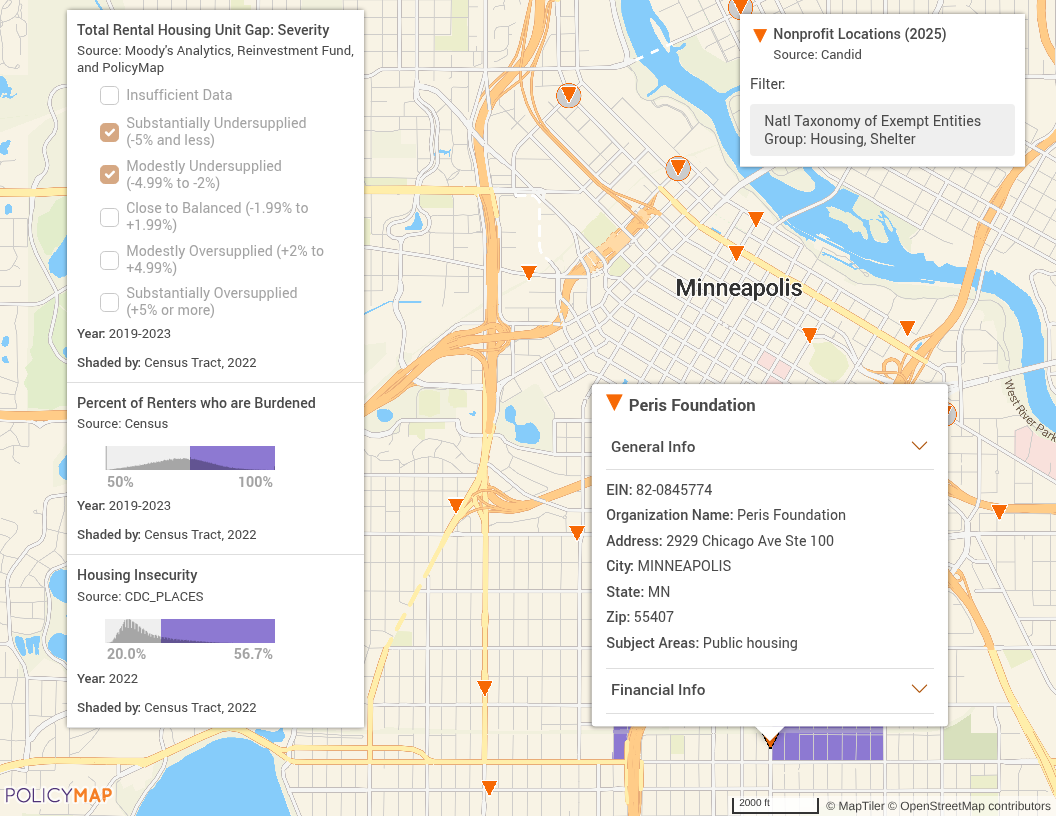Find the Right Community Partners for Your Health System—with Data

Hospitals and health systems are increasingly looking beyond clinical care to understand the broader factors affecting community health. But identifying local health needs, and finding the right partners to help address them, can be challenging. With PolicyMap, users can view community health data, including social determinants of health, risks, and outcomes, alongside nonprofit location data from Candid. This combined view makes it easier for health systems to identify local social and economic factors impacting health and find nonprofit organizations already working to address them.
Using Data to Drive Partnerships That Reduce Food Insecurity
Access to nutritious food is a cornerstone of good health, but many communities face ongoing barriers to healthy food options. In recent years, rising grocery prices have made the problem worse. Between 2020 and 2024, overall food prices in the U.S. increased by 23.6%, according to the Food Research and Action Center. For families already facing financial strain, these increases often force difficult trade-offs between basic needs, contributing to growing rates of food insecurity.
Request More Information
Contact us to learn more about how our platform can support your health system’s community health goals.
In Massachusetts, food insecurity rose by 59% between 2020 and 2021, the largest increase in the country according to a 2022 report by the Massachusetts General Hospital System. Food insecurity is linked to a range of chronic health conditions, including hypertension, coronary heart disease, diabetes, and kidney disease. With PolicyMap, health systems can identify neighborhoods within their service area that lack access to healthy food and locate community-based organizations with the expertise to address these challenges, all in one place.

For example, based on the findings from the report, the Massachusetts General Hospital System might look to partner with a nonprofit to address food insecurity in the Boston area. The map above shows the prevalence of food insecurity, as defined by the CDC, with darker purple areas indicating higher levels. This measure reflects the estimated percentage of adults in each census tract who would likely report that the food they bought did not last and that they lacked the resources to buy more.

PolicyMap’s platform allows users to overlay food insecurity data with Candid’s nonprofit location points, thus helping hospital systems identify potential nonprofit partners in areas of greatest need. Users can then filter these community-based organizations by area of focus, size, etc. The map above highlights only those nonprofits focused on food, agriculture, and nutrition.

If a hospital system wants to focus specifically on food-insecure areas that also lack nearby grocery stores and are experiencing adverse health outcomes, they can layer in health condition prevalence information as well as Reinvestment Fund’s Limited Supermarket Area (LSA) data, which identifies neighborhoods with inadequate and inequitable access to healthy food. Adding Candid’s nonprofit location data—filtered for organizations focused on food and nutrition—allows Massachusetts General Hospital System to gain a range of potential nonprofit partners located near these priority areas.

Clicking on a nonprofit location reveals key information, such as the populations served, thus allowing Massachusetts General Hospital System to quickly assess which organizations are strong candidates for collaboration. Additional community assets, such as grocery store locations, farmers’ markets, and SNAP retail locations, can also be overlaid and users can upload their own site locations, such as food pantries and mobile markets, as well.
To learn more about how food banks around the country use PolicyMap to address food insecurity in their communities, including Food is Medicine initiatives and other healthcare partnerships, check out this Feeding America use case.
Using Data Visualization to Drive Partnerships to Combat Housing Shortages and Insecurity
Housing insecurity is another critical social determinant of health that can be addressed through nonprofit partnerships. In a 2022 report, Hennepin Healthcare System in Minneapolis highlighted the importance of meeting basic needs, like stable housing, to improve health outcomes. At the time, 9.7% of Minneapolis residents had missed or delayed a housing payment in the previous year, with this figure ranging up to 26% for the city’s Hispanic residents. With PolicyMap, health systems can identify neighborhoods experiencing housing insecurity as well as locate community-based organizations focused on housing support in those areas, making it easier to build targeted, effective partnerships.

New research from Moody’s Analytics, PolicyMap, and Reinvestment Fund provides a detailed, census tract-level analysis of the U.S. housing shortage in cities with populations over 100,000. The data visualization highlights the housing gap, showing which neighborhoods have a shortage, surplus, or sufficient supply of housing units. For health systems looking to target housing investments, identifying areas that face both housing insecurity and a housing shortage can help pinpoint where collaboration with a housing-focused nonprofit could have the greatest impact.

The map above highlights areas in Minneapolis that have a modest to substantial rental housing shortage, a probability of housing insecurity of 20% or higher, AND that are heavily cost-burdened (with 50% or more of the community paying over 30% of their household income on rent). Layering on nonprofit locations that specialize in housing and shelter allows the Hennepin Healthcare Health System to see a range of partner options near these specific areas.

By exploring nonprofits near one of these target areas, Hennepin Healthcare can quickly assess whether potential partners exist for a housing initiative.
PolicyMap offers a wealth of additional housing-related data that can be layered onto the map to help gain deeper and more nuanced insights into a local area’s needs. Some examples include housing quality, homelessness, homeownership by race/ethnicity, vacancy rates, subsidized housing, and the locations of Community Development Financial Institutions, which often serve as key intermediaries and catalysts for effective local partnerships between healthcare organizations, housing developers, and other community partners. With access to a wide range of both housing and health indicators, health systems can explore where community needs align with their health improvement goals, helping to guide more strategic, data-informed partnerships.
PolicyMap can help you gain a deeper understanding of the complex housing challenges in your community. To learn more about PolicyMap’s housing use cases, click here.
Enhancing Health Outcomes Through Collaboration
Successful collaboration between health systems and nonprofit organizations starts with understanding the local landscape. Visualizing health indicators alongside nonprofit locations provides geospatial insights that enable targeted, data-driven strategies tailored to a community’s specific needs. While food insecurity and housing insecurity are two important examples, PolicyMap offers access to over 150 data sources on social determinants of health, including social context, financial security, healthcare access, and environmental factors. These insights empower health systems to strengthen their community health improvement plans by partnering with nonprofits where they can make the greatest impact.
Addressing complex issues like food and housing insecurity requires effective and sustainable partnerships, and PolicyMap can continue to support cross-sector collaborations as a valuable ongoing resource through its Partner Portal subscription, which provides a custom local PolicyMap site accessible for partners. As an example, this Interact for Health story describes how PolicyMap is leveraged as a collaborative resource to advance equitable health outcomes in the Greater Cincinnati region.
Ready to Discover Partners That Can Make a Difference in Your Community?
Use PolicyMap to visualize health needs and connect with local nonprofits working to improve outcomes. Reach out today to see how our platform can support your health system’s community health goals.